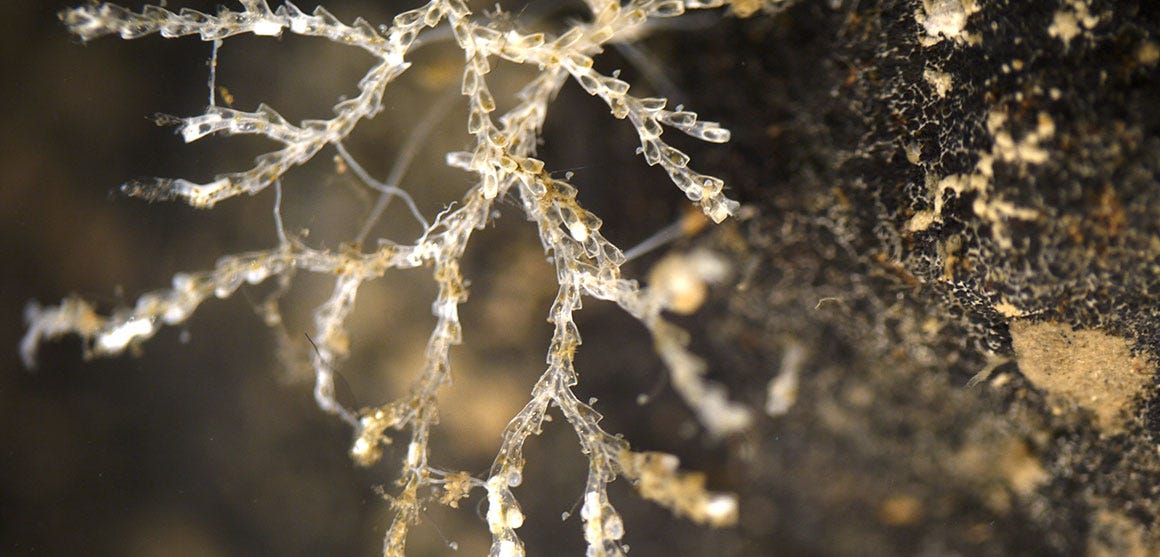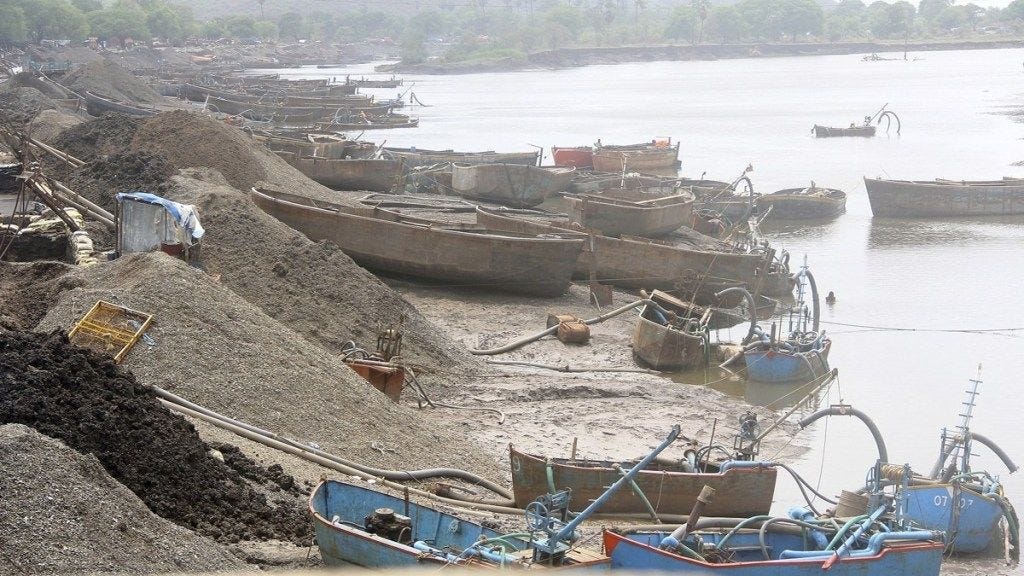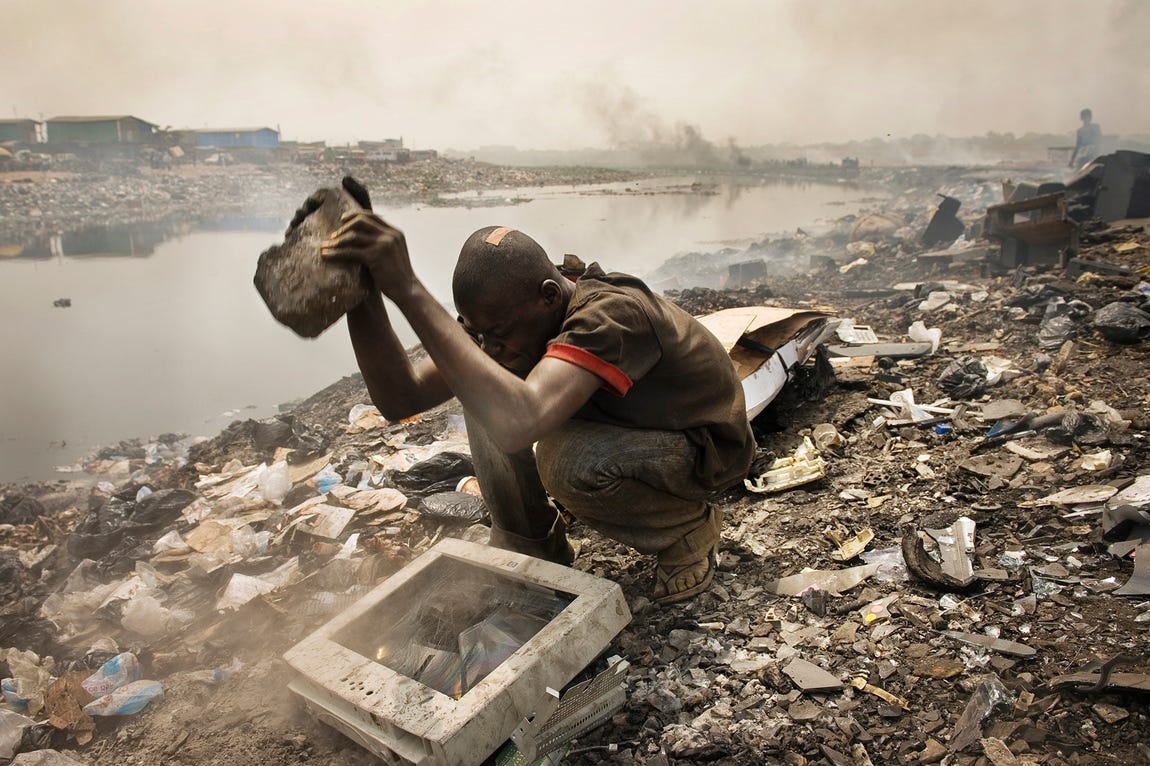Hidden Costs: Ecological Realism & The ‘Green’ Revolution
Hidden Costs: Ecological Realism & The ‘Green’ Revolution
Polymetallic Nodules, Sand Mafias and E-Waste Hazards
From the position of the archaeologist, technology is a neutral term. From flint hand axes to sickles, antler harpoons to fish traps, the earliest forms of technology leverage efficiency and capability at the interface between the human and the rest of the world. There is nothing unnatural about this - crows, otters, monkeys, even crocodiles make use of manipulated objects to exploit their dietary niche. Where there are concerns about how modern technology functions, they shouldn’t be framed as a dichotomy between ‘good’ and ‘bad’, but rather at the specific problems created. Too often what counts for academia today will position any discussion of technology in a framework of ‘neoliberalism’ and ‘systems thinking’. Some will talk of the Anthropocene, barely suppressing their glee at the control such definitions bring. What I want to do here is outline some concrete and non-systemic threats that specific technologies pose. It is my contention that only through approaching risks to the natural world in this way will we actually retain the ability to tackle them. Beyond the nebulous outlines of international agreements and porous commitments lies the bulwark of the nation state and its capacities, let us not be shy in demanding it makes use of them.
Mining the Sea-Floor: Polymetallic Nodules
The new Green Revolution and its consequences are rolling like a tidal wave across the world. One of its most insidious children is the ‘net-zero’ mining industry. To be absolutely clear, the new eco-friendly techno-complex of electric cars, wind and solar generated energy and the vast new infrastructure of batteries needed to support these relies precariously on this industry’s ability to extract unprecedented amounts of raw minerals. According to the World Bank’s 2020 report: Minerals for Climate Action, the increase in mineral production includes a staggering 488% increase in demand for lithium, 460% for cobalt, 231% for indium and a 189% increase for vanadium. The projections for the UK to meet its target for electric cars would require the world’s current output of neodymium, almost twice the world’s production of cobalt and three-quarters of the global lithium production. With two of the main countries for nickel, cobalt, manganese and copper being China and the Democratic Republic of Congo, the race has started to find alternatives mining venues. European nickel mines are one option, but by far the most enticing is the prospect of under sea mining.
Back in the deepest past, earth’s seawater began to slowly precipitate heavy metals. Manganese and iron oxyhydroxides began to scavenge cations of cobalt, copper and nickel, freed by the actions of undersea hydrothermal vents and the imperceptible metabolism of microorganisms, they settled over millions of years into polymetallic nodules. But why is this important? These nodules lie scattered all over the sea floor, most no larger than a duck’s egg, a gift from mother nature to a civilisation desperate for metals. The Clipperton Fracture Zone, a 4.5 million square kilometre expanse rich in manganese nodules, is just one prime example of the embarrassment of riches lying untapped and unused. The world has just realised that these treasure troves now need to be harvested and companies are applying for exploratory licences everywhere from Nauru to Mexico. Specialised sea craft with submarine vehicles now pioneer the extraction of nodules, suctioning, grinding, harvesting and crushing the metals before sending them up to the surface. What’s the problem I hear you ask, surely we need this?
The problem is that these nodules are not sterile globules of free resources, like some computer game world. They are in fact the underpinning keystone in a complex food web which we barely glimpse through the handful of studies which have focused on them. What we do know is this: the nodules themselves are coated with living beings, one in particular, the stalked glass sponge, is considered a key structural species. The trophic webs which exist in these deep abyssal zones rely on the nodules as the only physical structural support to anchor onto, the soft sediment being incapable of supporting these species. The cascading effects of removing the nodules flows upwards to the sediment and filter feeders, the scavengers, omnivores and carnivores. Equally as devastating are the fine sediment plumes created by the harvesters and the waste dumping after extraction, these clouds smother species to death and choke up life on the precarious reefs. Added to these known factors are the unknown risks - a 2016 study into the Clipperton Fracture Zone found that half of all the collected species were new to science. More dangerous (and ironic) is the possibility that deposits of frozen methane, known as methane clathrates, could be accidentally disturbed, potentially releasing unknown quantities of natural gas into the ocean and the atmosphere.
The question before us is - do we tear up a unique and important ocean ecosystem in order to fuel the Green Revolution? The cost-benefit analysis here should look at what this Revolution actually offers and whether it is desirable? It seems unlikely that all the ocean’s metals are going to remain unused, and no amount of international pressure will stop a country like China exploiting its own shoreline. But we needn’t all rush onwards with the charge for an electric battery powered world, there are alternatives.
Stripping the Dunes: Sand Extraction
On a list of conversational topics bound to cure insomnia, sand has to be near the top. Yet, this basic and seemingly ubiquitous material is rapidly becoming a coveted resource. How is this possible? Sand is required for a number of fundamental industries, including construction, road building, electronics, plastics, cosmetics, detergents, solar panels and water filtration. Due to the nature of the grains, desert sand is practically worthless, being too fine to bind together. This makes rivers, lakes and any accessible ocean the major targets for sand extraction and mining. On the face of it, this sounds reasonable. However, we have two huge problems here - firstly, the amount of available sand in the world is shrinking faster than it can be replenished; secondly, the damage caused to the environment, ecology and human habitation around the mined areas.
Sand extraction accounts for 85% of all mineral production globally by weight. Roughly 32 - 50 billion tons of sand is used annually, which, according to some models, will lead to demand outstripping supply before the century is out. Virtually every country imports sand, with the leading exporters, such as China and the United States, shipping 300 million tons in 2019. These figures are notoriously unreliable however since, as we’ll see later on, the illegal mining of sand is likely the largest supplier. As an example, between 2006 and 2016, Singapore imported 80 million tons of sand from Cambodia, but only 4% of that was through legal export channels. Since Singapore desperately needs sand for land reclamation and skyscraper building, the nearby countries have scoured billions of tons of sand for illegal export, so much so that Indonesia has physically lost over 20 islands, and another 80 are at risk.
Ecologically, sand mining at scale presents a number of problems: it lowers water tables, depletes wells, physically destroys habitats, alters the shape and flow of rivers, disrupts food webs, creates river bank instability, collapses bridges, changes the velocity of the river flow which can cause flooding and damage to property, leaches salt into agricultural land, dune removal can cause flooding, dust plumes can increase airborne radioactivity and damage health, and so on. The standard method for sand extraction is to dredge, at different scales and in a number of different ways. Ranging from Nigerians physically wading into the surf and carrying baskets of sand away on their heads, to Tamil truck drivers parking on tourist beaches and filling up using spades, to huge Chinese commercial ships complete with conveyor belts and barges, the nature of the work depends on the country and its legality. At the risk of repeating previous talking points, sand mining clearly has an immediate and long term impact on the ecology of the region. The physical removal of beaches, dunes, sand banks and river beds negates the ability of dependent wildlife and flora to survive, but another consequence is the spillover into violence in the human world.
Illegal sand mining seems like one of those minor headline topics, but the scale of the organisation goes far beyond what most people understand. Unauthorised sand extraction is the largest criminal enterprise in India, in particular the southern state of Tamil Nadu. In China, the Yangtze River has been a target for illegal extraction for decades, since the state banned mining in 2000. In 2019 alone police seized over 300 vessels, carrying approximately 100 million cubic feet of sand. Yet the theft continues, in part due to sophisticated GPS spoofing, which prevents authorities from accurately monitoring ship movement in real time, resulting in lethal collisions. Thane Creek, the river inlet from the Arabian Sea to Mumbai, swarms with hundreds of small wooden boats, all illegally scooping up sand from the river bed by hand. The divers used to make the plunge down to 20ft, a few years later they are at their physical limits of 40ft, soon the river bed will simply disappear. Like many similar illegal mines and dredge sites in India, they are run by mafias with the power to buy off local officials and murder journalists and protestors. On the larger geopolitical level, the tensions between Singapore and Indonesia/Malaysia have reached the point where the Indonesian navy has been deployed to arrest illegal sand miners in its territory.
E-Waste: Guiya, China & Agbogbloshie, Ghana
Along with reducing energy consumption and the replacement of fossil fuels with renewable energy is the third great eco-commandment: thou shalt recycle. Drilled into us as children and now for many an unconscious habit, the act of recycling is considered part of the virtuous package of green beliefs and an essential component in the ‘circular economy’. But recent scandals have exposed the great fraud of recycling and its empty promises. In 2018, under a policy called ‘National Sword’, China banned 24 types of plastic entering the country. At a stroke, the entire foundation of the world’s recycling system was demolished. Panic set in as countries began frantically searching for somewhere else to dump their trash. The harder questions then began to be asked, about how and why industrial nations are producing so much plastic. What was also discovered was the alternatives to China were horrifying, ranging from burning plastic in residential areas, to just dumping it in the ocean. Back in 2017 alarm bells should have been ringing when a research paper estimated that: since 2015, humans have produced roughly 6300 million metric tons of plastic, and that only 9% of it has been recycled. The remainder was either burnt (12%) or packed into landfill (79%).
Plastics, and the subsequent exposure of microplastics as a serious threat to human and animal health, have dominated the environmental headlines for the last few years. But the question of electronic waste - e-waste - has been relatively under-discussed. Electronic and digital infrastructure is often touted as the greener and more eco-friendly of any given option - banks often ask you to review your statement online, rather than print one on paper. But this ignores the immense damage that electronics cause, during their production and particularly during their disposal. The full list of chemicals and substances found within e-waste is vast, but some of the more potent include: brominated flame retardants, polybrominated diphenyl ethers, polybrominated biphenyls, polychlorinated biphenyls (PCBs), polychlorinated dibenzodioxins, polyaromatic hydrocarbons, lead, chromium, cadmium, mercury, lithium, arsenic and bismuth. The sheer volume of this waste has ballooned out of control; China alone was estimated to have produced 15 million metric tons in 2020. In general we can categorise e-waste into three main types - large household appliances (fridges, freezers etc), personal equipment (smartphones, tracker gadgets, TVs) and IT equipment (monitors, servers, fibre optic cables etc). All of these are set to increase as the costs of production have lowered for the average consumer and as more countries develop their digital infrastructure.
The movement and shipping of e-waste is, in principle, subject to control through the Basel Convention (in force since 1992). However, without the ratification of the United States and with precious little enforcement mechanisms, the Convention has failed to prevent millions of tons of e-waste being transported and dumped across the world. One place in particular has garnered international attention - Agbogbloshie, Ghana - and is listed among the top ten most toxic places on earth. Despite some substantial hyperbole about illegal e-waste trafficking, the waste dump near the centre of Accra does pose a huge health risk, both to the adults and children working there, and the greater environment of the coast of the Gulf of Guinea. In particular the open fires used to melt the plastic from copper wiring and the subsequent extraction by hand of precious metals and electronic components without safety equipment causes horrific neurological and physical harm to the workers. Similarly, in Guangdong, China, the former rice village of Guiya was quickly established as the electronic graveyard of the world. In the early 2000’s, over 60,000 people were employed under the most primitive conditions to harvest and extract valuable metals from e-waste, sent from all over the world. Burning plastic, soaking chips in acid baths, breathing in dioxin tainted ash; the workers were recovering gold, toner, copper and silver. The water became undrinkable and had to be brought from elsewhere, rice could not be grown, children were exposed to critical levels of lead, toxic dust saturated with chromium, nickel and zinc settled over the town. Since 2007 the area has been subject to state-led efforts to raise safety and health standards, but the pollution and contamination is likely permanent and has yet to be dealt with.
One major incentive to bring e-waste recycling back under national controls is the growing problem of data security within e-waste. All those mobile phones, hard drives, servers and consumer gadgets are packed with passwords, personal data and in some cases even state secrets. Journalists reporting on Agbogbloshie went rummaging through the informal markets which surround the dump, they found a hard drive containing unencrypted sensitive US Government data:
A team of journalists investigating the global electronic waste business has unearthed a security problem too. In a Ghana market, they bought a computer hard drive containing sensitive documents belonging to U.S. government contractor Northrop Grumman… They were marked "competitive sensitive" and covered company contracts with the Defense Intelligence Agency, the National Aeronautics and Space Administration and the Transportation Security Agency.
Organised crime in Ghana has realised the goldmine of information that Agbogbloshie represents and regularly purchases hard drives, looking for useful data:
The students take the hard drives to Regent University in the Ghanaian capital and ask computer scientist Enoch Kwesi Messiah to help read what is on them. Within minutes, he is scrolling through intimate details of people's lives, files left behind by the hard drives' original owners. There is private financial data, too: credit card numbers, account information, records of online transactions the original owners may not have realized were even there.
“ I can get your bank numbers and I retrieve all your money from your accounts,” Messiah says. “If ever somebody gets your hard drive, he can get every information about you from the drive, no matter where it is hidden.”
That's particularly a problem in a place like Ghana, which is listed by the U.S. State Department as one of the top sources of cyber crime in the world
Conclusions: The Return Of The State?
I selected the three problems addressed in this article - polymetallic nodule mining, sand extraction and e-waste - as good examples of the relationship between the environment, technology, health and the State. The 90’s paradigm of globalisation outstripping the nation-state and rendering it obsolete has thankfully run its course, although some tone-deaf commentators and ideologues are still wedded to the ‘market first’ vision of humanity. What has come screeching back into the void of COVID-19, the retreat of US hegemony and the rise of China is the fundamental importance of national governance. Some, like the UK, are beginning to realise how withered their powers have become, others like China are confidently asserting their muscle. The control of national territory, especially in the ocean; the enforcement of national treaties; the ability to shut borders to the flow of material goods; the development of safety protocols and infrastructure for recycling critical technologies (eg batteries); the protection of ecological assets, and the ability to tackle organised and transnational crime are all fundamental tasks of the nation-state. While the left wing environmentalists are correct that pollution or biodiversity depletion doesn’t magically stop at the border, what we must recognise is that handing over national autonomy to international organisations not only hasn’t helped, but neuters the very tools needed to reign in the excesses of modernity. This is not to argue that national cooperation, treaties, international agreements and so forth can’t be realised - they absolutely can, and they are best done through a strong national and territorial framework. I will finish here by reflecting on my opening remarks: technology changes the way humans relate to their environment, and leverages their capacities. Many technologies have huge downsides as well as enormous benefits, and the best way to retain an optimal asymmetry is for the different techno-complexes to be under the control of a sovereign state.
Source: Grey Goose Chronicles



Comments
Post a Comment